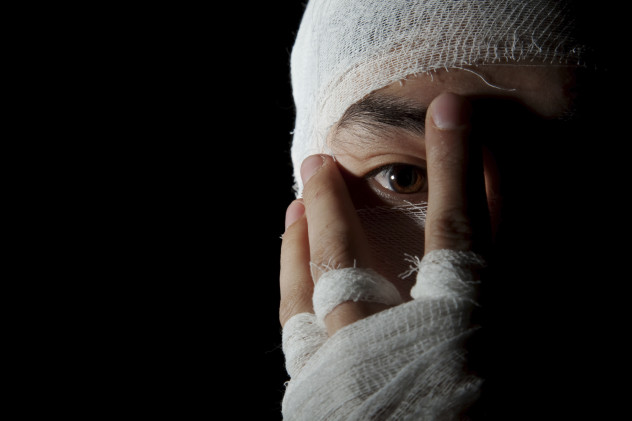However, the technique has been thoroughly discredited and today it seems like the silliest thing ever—but it didn’t even happen all that long ago. Thousands of people were lobotomized for problems such as depression or difficult behavior just decades ago. Some of these people are still living and still suffering from the effects of botched or irresponsibly performed operations that severed connections in their brains permanently. The history of the lobotomy is ugly, and the scars still remain.
10The Procedure Won A Nobel Prize
Today, the lobotomy is seen as an embarrassing failure of recent psychiatry, but during the craze it was a very respected procedure. It was first developed by Egas Moniz, a Portuguese doctor who had first tried something he called a prefrontal leucotomy. He used it to treat schizophrenia and found patients were more manageable afterward. Over time, another doctor named Walter Freeman developed it into the quick, behind-the-eyeballs method that we know of today called the transorbital lobotomy. In 1949, Moniz actually won a Nobel Prize for his invention of the procedure. At the time, this gave huge legitimacy to a procedure we had hardly yet tested. Soon, thousands were getting lobotomies all over the world. The relatives of some of the lobotomy victims are trying to get the Nobel committee to rescind the award considering the incredible amount of damage the procedure has done. Unfortunately, the Nobel committee has flatly refused to consider the idea and instead wrote a comprehensive rebuttal of why their decision should stand. For starters, they believe it was still a better alternative at the time than other schizophrenia treatments, and they believe he was still advanced for his day so they don’t agree their award was in error. It’s also important to note that rescinding a Nobel Prize like that would be unprecedented. The Nobel committee has never revoked an award and, as it is against their policies, they likely never will. Egas Moniz’s Nobel Prize will likely stand for all history.
9Some Thought It Was Better Than The Alternative
Some people may wonder how a practice where you are basically jamming an ice pick behind someone’s eye and tearing apart connections in their brain would become so popular. While it did reach fad status eventually, at first the real point of it was to help people suffering from schizophrenia or other severe mental illnesses. The doctors who approved the lobotomy operation didn’t know all the risks and were performing brain surgery without being able to see what they were doing, but many were still doing it for the right reasons. They felt that mental hospitals of the day were such horror shows for patients that perhaps this procedure could help them lead something of a normal life. The problem was that back then we really didn’t have drugs that could calm down out-of-control patients, and keeping a violently insane person from hurting themselves or others offered unique challenges. The patients often had to be restrained like prisoners in straitjackets and put in padded rooms. Without drugs, patients had to be forcibly controlled and physically restrained—this meant violence was common. Treatments were often brutal and, with no real way to cure or treat schizophrenia, many of the patients had no other hope of ever seeing the light of day. For both patients and doctors it was a way out of a terrible situation—it just wasn’t the right way.
8Patient Follow-Up
Moniz was the pioneer of the lobotomy and Freeman’s zeal quickly made it popular in the US, but the two of them often did not see eye to eye. Moniz felt that the ice pick method popularized by Freeman was not the most responsible way to perform surgery on someone’s brain. Soon, Moniz created distance between the two of them. However, while Freeman may have been poking into people’s brains a little too enthusiastically for his own good, Moniz had his faults as well when it came to patients. Moniz was not really known for spectacular follow-up with patients which is alarming considering he was performing a brain surgery that was basically untested. He was known for keeping his follow-up to examining people for just a few days after he permanently severed connections in their brains, and many people felt that his criteria for determining whether a patient was actually doing better was far too biased and rooted in desire to see positive results. In other words, he found positive improvement in most people because he wanted to see it. On the other hand, Freeman may have been performing a more barbaric form of the practice, but he believed strongly in following up with patients and did so until his death.
7Surgically Induced Childhood
Freeman, who helped Moniz develop the lobotomy as it is today and helped popularize it in the US, had a term for people who had recently gone through the lobotomy procedure called “surgically induced childhood.” He believed that the lack of many normal mental capabilities, the distraction, the stupefaction, and other issues were because the lobotomy patient was regressing to a younger mental age. However, Freeman did not think that it was permanent damage caused to the personality by his butchering. Rather, he thought that the patient would eventually start to mature again. He believed when the maturation started again it would be quick and eventually lead to a full recovery. In the interim, he suggested treating the patients (even if they were adults) like they were actual children if they misbehaved. He even suggested that two parents hold down and spank their adult daughter if she gave them trouble and that they should give her ice cream and kisses afterward. The regressive behaviors that often occurred after a lobotomy rarely faded with time and instead often crippled the person mentally and emotionally for life. In many cases, those who had the procedure performed on them often had incontinence problems or other childlike behaviors such as a propensity to be excited by various stimuli, trouble paying attention, and angry outbursts. Some people would say this is still better than schizophrenia considering the treatments at the time, but it leaves the question of whether people would really want to live that way with their personality so fundamentally altered.
6Informed Consent
Today, before you get any major mental or physical treatments, doctors have to first make sure to inform you fully of what is going to happen and what the risks and complications are. You need to be able to show you have full mental faculties to make the decision and sign several documents. However, back when the lobotomy held sway, people didn’t have nearly as many rights when it came to informed consent. In fact, informed consent pretty much didn’t exist at the time and surgeons often handled things how they wanted. Freeman did agree that a patient too far removed from their normal mental health faculties probably wasn’t okay to consent to a lobotomy. However, Freeman would not be deterred by something as simple as that. If he couldn’t get consent from the patient he’d go to the relatives in the hopes one of them would approve it. To make matters worse, if a patient had already agreed and tried to back out at the last minute, the doctor would ensure that they got the operation even if he had to have them sedated. In many cases, people were being forced into the procedure against their will by doctors and family members that may not have been malicious but were certainly irresponsible.
5It Destroyed People’s Lives
The doctors at the time claimed huge success rates for their operation and very little in the way of actual damage to the brains of their patients. The problem was that many of the people they took on as patients were severely mentally ill. The lobotomy in many cases either turned them into a vegetable or simply made them more docile, passive, and easy to control—often much less intelligent as well. Many of the doctors took this as being “good progress” because they didn’t know how else to treat severely mentally ill patients. During the days of the lobotomy, unless it killed someone they considered all of the permanent brain damage be a negative side effect of the treatment. Many of the people who have asked for the Nobel Prize awarded to Moniz to be rescinded have complained that they or their family members not only weren’t cured but suffered permanent damage that changed who they were and, in some cases, made it impossible for the individual to live a normal life. In one case, a pregnant woman was given the procedure simply for headaches, and afterward she was never the same again. It was more than just being like a child; she could not feed or take care of herself at all—it took her years just to relearn basic tasks. In another case, a boy named Howard Dully was lobotomized by a stepmother who didn’t like him, simply for being a difficult child. Freeman seriously recommended it as a way to change the child’s personality, and Dully spent most of his life feeling like a part of himself was missing.
4Surgery Theater
Some of the same people who wanted the Nobel Prize taken away from Moniz also felt that Freeman was a little too excited about getting to use his ice pick lobotomy procedure whenever he got the chance. It wasn’t just because of his lack of desire to properly inform his patients but the fact that he was known for putting on a show to excited audiences. Freeman would often complete the procedure in only 10 minutes, which seems like a grossly inadequate amount of time to perform something as delicate as brain surgery, even if it were the most useful operation in the world. Unfortunately, the doctor did not agree. He once performed a staggering 25 lobotomies in a single day. He would first—mercifully—use electroshock to render patients mostly unconscious, but that was as far as his ethics and foresight went. After that, he would insert his ice picks and start severing brain connections. To make matters worse, sometimes he would do both sides of the brain at the same time just to show off. It’s impossible to know how many people may have ended up in worse shape because he spent less time on brain surgery than most people do deciding what to eat for dinner, but considering the slapdash surgery, it’s not surprising many people did not fare well after the procedure.
3It Wasn’t Just Used For Severe Mental Problems
We touched on this earlier—the lobotomy has been used for behavioral problems and also in an attempt to cure things like chronic headaches, but the list of things it was used for is much longer. While it started as a last ditch cure for severe cases of schizophrenia when there weren’t many other options, Freeman’s and Moniz’s zeal soon turned it into a full-blown medical fad. People were bringing in their friends, family members, or even themselves to get lobotomies for all kinds of different problems. There was even a time when the lobotomy was considered a possible cure for homosexuality. While Moniz preferred more medical forms of the procedure and was a bit more reticent, Freeman really wanted to use it on anyone who wanted one or wanted their family member to get one. He would give people lobotomies for migraines, depression, postpartum depression, behavioral problems, mild retardation, or really anything that he fancied would get him a chance to stick an ice pick in someone’s brain. He was not evil—just insanely convinced that his operation was a great idea for almost everyone. Some sources say he operated on multiple children under the age of five whom he suspected of being schizophrenic. However, it is important to note that schizophrenia typically does not show up that early and it would be irresponsible to make a diagnosis at that age.
2The 2,000 Lobotomized War Veterans
Many people thank soldiers for their service in the US, and there is even a federal holiday for war veterans. However, many veterans suffer from mental health problems and many of them are homeless. It is a sad truth that although many US citizens are proud of those who perform military service, many poor members are not being well taken care of. After World War II, there was a huge influx of soldiers coming back from the war with traumatic experiences and not much of a mental health care system to take care of them. Instead of taking the time to attempt to treat and rehabilitate as many people as possible, the Wall Street Journal discovered that about 2,000 soldiers were given lobotomies—many against their will. And, just like civilian victims of the lobotomy, many of them received the treatment for absurd things like depression and the other symptoms that were likely from post traumatic stress disorder (PTSD) and also sometimes homosexuality. Many of these soldiers were sent home with a very disturbing informational pamphlet on how their families could take care of their now permanently brain-damaged relative. The pamphlet is very long and describes possible scenarios and advice. It explains in great detail that the lobotomized family member will lose interest in things easily, stare off into space, speak inappropriately, act like a child, and be listless and difficult to manage. Despite this person having clearly gone through severe trauma, having recently fought in a war, and having just received brain surgery, it makes it clear that you absolutely must not allow the person to rest, relax, or sleep in at all. The pamphlet also points out that this person will basically need constant attention for the rest of his or her life.
1The Chemical Lobotomy Drug
The lobotomy is considered today to be an absurd and barbaric procedure from when we didn’t know what we were doing, but it was embarrassingly recent. We would like to think that the lobotomy disappeared because we collectively came to our senses, but in actuality it was simply displaced by a more effective treatment. Aside from people like Freeman who zealously pushed it as a life’s obsession, many doctors weren’t particularly comfortable with the procedure, but they did it when they felt there was nothing else that would work. Once psychotropic drugs started to come into play, the lobotomy started to quickly lose popularity. A new drug called Thorazine started to take hold and was at first called a “chemical lobotomy.” The main thing most creditable doctors were using the lobotomy for was for the treatment of serious psychotic symptoms—something Thorazine excelled at. While the lobotomy was used to treat other disorders, it was no longer being used so widely for schizophrenia and it simply couldn’t sustain popularity. People had moved on to treating mental health problems with drugs. Some people were afraid it might still change someone’s personality, but it had the advantage of not turning patients back into confused children who couldn’t care for their basic bodily functions. Soon, the lobotomy quickly fell out of favor. Today, some people even see it as a punch line, but for those who received one it was no laughing matter.
























